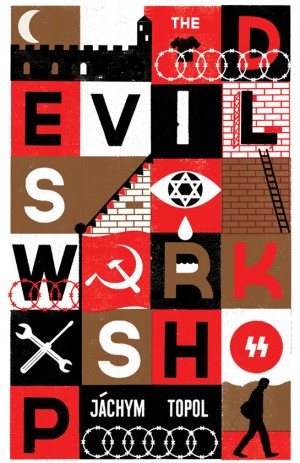You have no items in your cart. Want to get some nice things?
Go shopping“I wanted to work out what Eastern Europe really was, since we may look the same but culturally we’re different. So where is the real East? I wondered. The Slovaks all told me I’d stopped too soon – Slovakia was Central Europe, not Eastern! Same as those stupid Czechs back there, sorry to say, not to mention the Hungarians, they aren’t even really in Europe.”
Jáchym Topol, in The Devil’s Workshop, has chosen a darkly comic way of relating the horrors of the past to the present. The unnamed narrator is inspired by his uncle Lebo to embark on a project to turn the crumbling town of Terezín, the site of a ghetto and concentration camp during the Second World War, into a tourist attraction.
Topol, born in 1962, is known for his political engagement in his personal life and in his writing. He was one of the signatories of the Charter 77 human rights declaration in communist Czechoslovakia and during the 1989 Velvet Revolution he wrote for one of the first independent magazines ‘Respekt’, founded after the fall of Communist party. His previous novel translated from Czech, Gargling with Tar, was set during the crushing of the Prague Spring by the Russian invasion of Czechoslovakia in 1968.
In a recent interview Topol stated that: ‘I am obsessed by the past and I hate it. This is why I hate myself, because this fascination with the past is a sort of obsession.’ Topol’s fascination with the past led him to revisit in The Devil’s Workshop the sites of the massacres of the Second World War set in the contemporary Czech Republic and Belarus with a deeply moving tenderness and bleak humour.
Inspired by the commercial success of the tourism industry in the Czech Republic a visitor to Terezín can purchase Kafka T-shirts or, copied from another concentration camp site near Kraków in Poland – Auschwitz, a ghetto pizza. And there are as well therapy sessions for the young people whose family members were murdered in ghetto. The ghoulish entertainment becomes so successful it begins to spark a great deal of interest among tourists and foreign journalists, ‘You’re in the heart of darkness here, touching the depths of horror, it’s irresistible!’ says one of the journalists. Eventually however the local authorities, fearing the competition to its official museum, bulldoze the stalls and buildings where the group of young people led by uncle Lebo has set up its activities.
“They killed four million people here. It’s in the Guinness Book of Records! And you know how many people there were in Czechoslovakia and how many in Belarus?
No
The same. Ten million. But you in the West, you don’t have a clue! Terezín was nothing!
What is she getting angry about? I guess the dezhurnaya got her upset.
The world never saw camps like we had here in Belarus! Maruška yells.
Maruška!
They say all death camps were in Poland. That’s bullshit! All the tour operators only got to Auschwitz! But that’s going to change. P.”
In the second part of the novel, the narrator flees to Belarus, where he finds himself unexpectedly commissioned to repeat his success of marketing Terezín with another memorial site – Khatyn.
On 22 March 1943 the 118th Schutzmannschaft battalion, formed of Ukrainian collaborators and a Waffen-SS special battalion, murdered the entire population of Khatyn: 149 people, including 75 children. Alex, involved in Terezín project and now in Belarus, says: ‘It’s going to be the most famous memorial site in the world. The devil had his workshop here in Belarus. The deepest graves are in Belarus. But nobody knows about them.’
In the course of this short novel, which took Topol twenty years to write, there’s a sense of growing frustration among Topol’s characters directed at the ignorance of the West towards Eastern Europe and its history which can only be brought to light through the means of bleak commercialisation. For the characters, this horror trip into Belarusian past seems to be the only solution to get their country on the map.
Ironically, in a country ravaged by authoritarian dictatorship, there isn’t anything else for the young generation of Belarus. Topol plays on the stereotypes but you can’t help but think he has a point: ‘Thailand: sex. Italy: paintings and seaside. Holland: clogs and cheese. Right? And Belarus? Horror trip, right?’ Though Topol’s prose can be devoid of nuances this is a powerful novel about the individual’s engagement with the demons from the past and the reality of alienating globalised capitalism where anything can be marketed and sold, even death.
“Guess who had the most casualties during the war? We did! Guess who had the most people murdered under communism? We did. And guess who still has people disappearing, eh? We do! That’s the division of labour in the globalized world of today, damnit! Thailand: sex. Italy: paintings and seaside. Holland: clogs and cheese. Right? And Belarus? Horror trip, right? Don’t look so serious, for fuck’s sake! Arthur bellowed. You could tell he was used to giving out orders.”
The Devil’s Workshop was published in August 2013. Buy it from Foyles.

About A. M. Bakalar
A. M. Bakalar was born and raised in Poland. She lived in Germany, France, Sicily and Canada before she moved to the UK in 2004. Her first novel, Madame Mephisto, was among readers’ recommendations for the Guardian First Book Award. She is the first Polish woman to publish a novel in English since Poland joined the EU in 2004. A. M. Bakalar lives with her partner—a drum and bass musician—in London. She is currently at work on her second novel.





